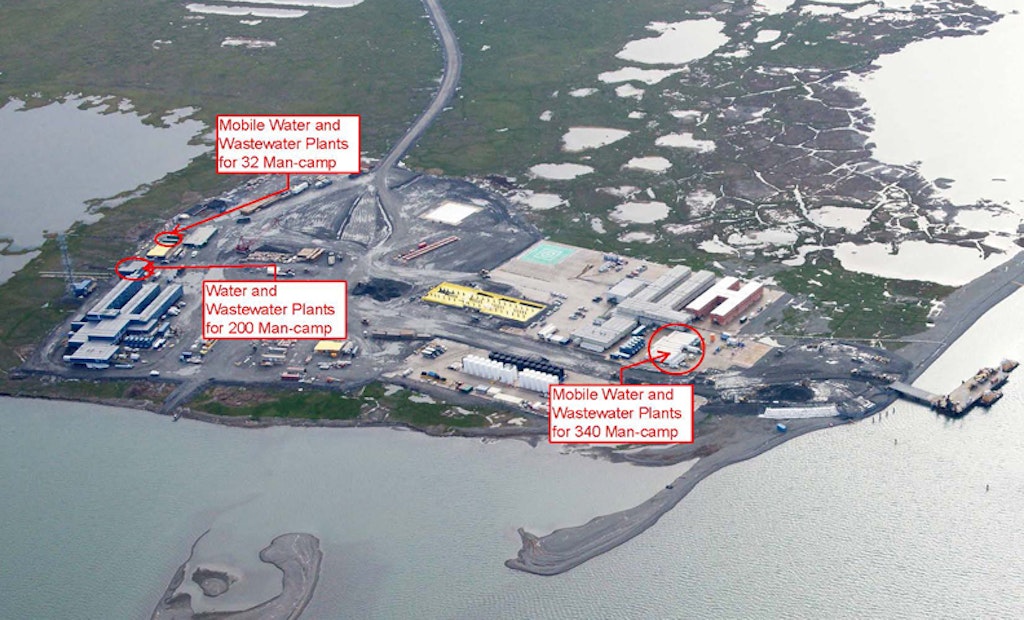
Interested in Systems/ATUs?
Get Systems/ATUs articles, news and videos right in your inbox! Sign up now.
Systems/ATUs + Get AlertsYou can’t drive there most of the year. Temperatures of -40 degrees F are common – the lowest recorded temperature was -62 degrees in 1989. Still, more than 1,100 people worked there last winter.
Installing water and wastewater infrastructure at Point Thomson on the North Slope of Alaska fell to Lifewater Engineering Company of Fairbanks and Project Engineer Wes Hopwood. “It’s a very remote site,” he says. “In the winter, they build an ice road out there.”
Point Thomson is a natural gas condensate field being opened on Alaska’s North Slope 60 miles east of Prudhoe Bay adjacent to the Arctic National Wildlife Refuge. It holds about 25 percent of the known North Slope gas reserves, according to the Alaska DNR. Its 22-mile, 70,000 barrel per day pipeline will connect to the trans-Alaska pipeline.
Under contract with ICE Services, Lifewater Engineering installed ultrafiltration membrane bioreactor wastewater treatment systems from Membrane Specialists at the 270-acre Point Thomson project.
A small mobile camp was built in 2009, a large mobile camp and a permanent camp opened in April 2013. They also installed nanofiltration systems from Membrane Specialists to provide drinking water to the camps and provided training for those who will operate the systems:
- 200-person permanent camp: 12,000 gpd crossflow membrane bioreactor with a Volute dewatering press (PWTech) housed in ten 40-foot shipping containers placed on a 60- by 40-foot piling structure.
- 340-person mobile camp: 18,000 gpd membrane bioreactor with a Volute dewatering press housed in a dozen 53-foot reefer vans on a 60- by 100-foot gravel pad.
- 32-person mobile camp: 2,000 gpd membrane bioreactor in four shipping containers stacked on a 40- by 8-foot gravel pad. The solids from this camp are shipped to one of the other two camps for dewatering.
Equipment for the mobile sites sits on pads of 10 to 12 feet of gravel installed on top of the permafrost. “The pads are always settling and moving,” Hopwood says. Water storage and fire suppression take up the most space.
“The membrane wastewater treatment system is fairly compact,” Hopwood says. “You have to have a lot of water storage in case trucks can’t get out to fill the water tanks.” Fresh water, high in organics, is taken from area tundra ponds. Treated effluent is discharged to the ocean or to a tundra pond. Dewatered solids are landfilled.
Lifewater was able to truck all the equipment to Point Thomson in February and April over ice roads. Easier than shipping by barge, but still no easy task. The trucks first drove 400 miles from Fairbanks to Deadhorse, a 15-hour drive on a “highway” that is mostly pot-holed gravel. It’s a three-hour trip from there to Point Thomson over the ice road.
“One challenge is getting everything out there before the ice road closes,” Hopwood says. It’s never certain when it will open or close; that all depends on the weather. In recent years, it has generally been open from January to May. Weather can also affect transportation logistics; it’s not uncommon for ground blizzards to close the road for a few days at a time.
Not only does equipment have to work in the frigid, windy conditions of the North Slope, it first has to survive the trip. “The means of transportation has to be considered early in the design,” Hopwood says. “We have to build them very durable so they can withstand the shipping and handling. It’s very cold, and that makes things very brittle. Most things are built to be shipped cold, but some of the modules were heated during shipping as a precaution.”
Once on site, equipment and storage tanks are housed in heated containers with vapor barriers to prevent condensation from freezing inside the walls. “Everything is heat traced; air vents, exterior piping, and any connections between modules have to be protected from freezing,” he says. Treated effluent from the systems is discharged to the ocean or to a tundra pond. Dewatered solids are landfilled.
Systems are also kept as simple as possible because getting service people to the camps is very difficult. “It can’t be done quickly so we keep a lot of spare parts on site,” he says. “If we have to bring someone in from the lower 48, it would take four days to get there if everything goes well.”
Flying in used to take two days, but now that Point Thomson has an airstrip, someone from Fairbanks can get there the next day if the weather permits – but planes only fly on weekdays.
Hopwood says life in a man camp involves long 12-hour shifts in tough conditions, but the companies try to keep everyone comfortable while they are off duty. Reliable access to water and sanitation are essential, and Lifewater Engineering’s experience proves that it’s a difficult challenge to meet.





